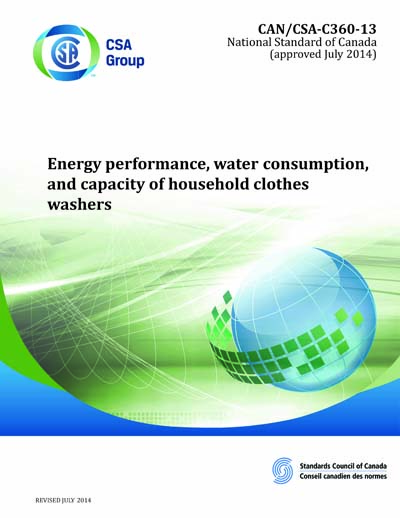Historical
CAN/CSA C360-2013 (R2018)
Energy performance, water consumption and capacity of household clothes washers
Preface This is the sixth edition of CSA C360, Energy performance, water consumption, and capacity of household clothes washers. It supersedes the previous editions, published in 2003 under the title Energy Performance, Water Consumption, and Capacity of Automatic Household Clothes Washers, and in 1998, 1992, 1989, and 1980 under the title Test Method for Measuring Energy Consumption and Capacity of Automatic Household Clothes Washers. This Standard specifies the methods used to measure the capacity, energy consumption, water consumption, and energy efficiency of household and household-style commercial clothes washers, as well as the energy consumption limits, where applicable. This Standard has been updated to take into consideration the changes in testing and evaluating the energy efficiency of household clothes washers specified in the final rule of the United States Department of Energy (DOE) publication 10 Code of Federal Regulations (CFR), Part 430 Subpart B, Appendix J2. Scope 1.1 This Standard applies to soft-mounted a) horizontal-axis and vertical-axis compact and standard household automatic or semi-automatic clothes washers; and b) household-style commercial clothes washers. 1.2 This Standard does not apply to wringer washers or twin tub washers/spinners. 1.3 Machines that contain an adaptive control system may be tested in accordance with this Standard, provided that the machine can be set to a cycle, either through default or through operator selection, that a) corresponds to the cycle recommended by the manufacturer for washing cotton and linen; or b) has a cycle time in accordance with the requirements of Clause 4.3.3. Note: For the purposes of this Standard, the default setting or cycle is referred to as the "normal cycle" or "energy test cycle". 1.4 In this Standard, "shall" is used to express a requirement, i.e., a provision that the user is obliged to satisfy in order to comply with the standard; "should" is used to express a recommendation or that which is advised but not required; and "may" is used to express an option or that which is permissible within the limits of the Standard. Notes accompanying clauses do not include requirements or alternative requirements; the purpose of a note accompanying a clause is to separate from the text explanatory or informative material. Notes to tables and figures are considered part of the table or figure and may be written as requirements. Annexes are designated normative (mandatory) or informative (non-mandatory) to define their application. 1.5 The values given in SI (metric) units are the standard. The values given in parentheses are for information only.
Content Provider
CSA America, Inc. [csa]






